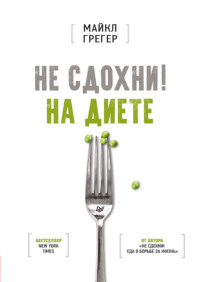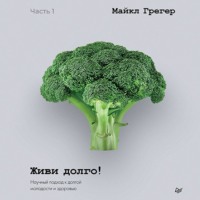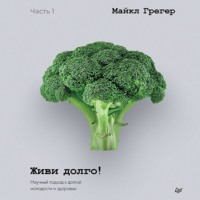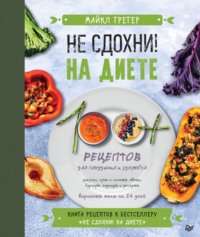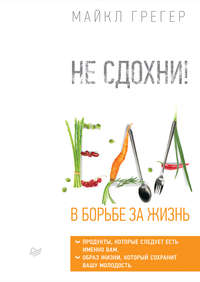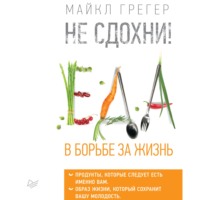
Полная версия
Живи долго! Научный подход к долгой молодости и здоровью
Weber C. Nutrition. Diet change alters microbiota and might affect cancer risk. Nat Rev Gastroenterol Hepatol. 2015;12(6):314. https://pubmed.ncbi.nlm.nih.gov/25963512/
3461
Zhao Y, Zhan J, Wang Y, Wang D. The relationship between plant-based diet and risk of digestive system cancers: a meta-analysis based on 3,059,009 subjects. Front Public Health. 2022;10. https://pubmed.ncbi.nlm.nih.gov/35719615/
3462
McCarty MF. Mortality from Western cancers rose dramatically among African-Americans during the 20th century: are dietary animal products to blame? Med Hypotheses. 2001;57(2):169–74. https://pubmed.ncbi.nlm.nih.gov/11461167/
3463
Milsom I, Gyhagen M. The prevalence of urinary incontinence. Climacteric. 2019;22(3):217–22. https://pubmed.ncbi.nlm.nih.gov/30572737/
3464
Wieland LS, Shrestha N, Lassi ZS, Panda S, Chiaramonte D, Skoetz N. Yoga for treating urinary incontinence in women. Cochrane Database Syst Rev. 2019;2:CD012668. https://pubmed.ncbi.nlm.nih.gov/30816997/
3465
Pearlman A, Kreder K. Evaluation and treatment of urinary incontinence in the aging male. Postgrad Med. 2020;132(sup4):9–17. https://pubmed.ncbi.nlm.nih.gov/33017202/
3466
Faleiro DJA, Menezes EC, Capeletto E, Fank F, Porto RM, Mazo GZ. Association of physical activity with urinary incontinence in older women: a systematic review. J Aging Phys Act. 2019;27(4):906–13. https://pubmed.ncbi.nlm.nih.gov/30859902/
3467
Specht JKP. 9 myths of incontinence in older adults: both clinicians and the over-65 set need to know more. Am J Nurs. 2005;105(6):58–68. https://pubmed.ncbi.nlm.nih.gov/15930873/
3468
Muller N. Myths about incontinence in aging adults. Ostomy Wound Manage. 2009;55(5):22. https://pubmed.ncbi.nlm.nih.gov/20560204/
3469
Milsom I, Gyhagen M. The prevalence of urinary incontinence. Climacteric. 2019;22(3):217–22. https://pubmed.ncbi.nlm.nih.gov/30572737/
3470
Specht JKP. 9 myths of incontinence in older adults: both clinicians and the over-65 set need to know more. Am J Nurs. 2005;105(6):58–68. https://pubmed.ncbi.nlm.nih.gov/15930873/
3471
Pizzol D, Demurtas J, Celotto S, et al. Urinary incontinence and quality of life: a systematic review and meta-analysis. Aging Clin Exp Res. 2021;33(1):25–35. https://pubmed.ncbi.nlm.nih.gov/32964401/
3472
Milsom I, Gyhagen M. The prevalence of urinary incontinence. Climacteric. 2019;22(3):217–22. https://pubmed.ncbi.nlm.nih.gov/30572737/
3473
Ashton-Miller JA, DeLancey JOL. Functional anatomy of the female pelvic floor. Ann N Y Acad Sci. 2007;1101:266–96. https://pubmed.ncbi.nlm.nih.gov/17416924/
3474
Kuh D, Cardozo L, Hardy R. Urinary incontinence in middle aged women: childhood enuresis and other lifetime risk factors in a British prospective cohort. J Epidemiol Community Health. 1999;53(8):453–8. https://pubmed.ncbi.nlm.nih.gov/10562862/
3475
Danforth KN, Townsend MK, Lifford K, Curhan GC, Resnick NM, Grodstein F. Risk factors for urinary incontinence among middle-aged women. Am J Obstet Gynecol. 2006;194(2):339–45. https://pubmed.ncbi.nlm.nih.gov/16458626/
3476
Robinson D, Giarenis I, Cardozo L. You are what you eat: the impact of diet on overactive bladder and lower urinary tract symptoms. Maturitas. 2014;79(1):8–13. https://pubmed.ncbi.nlm.nih.gov/25033724/
3477
Imamura M, Williams K, Wells M, McGrother C. Lifestyle interventions for the treatment of urinary incontinence in adults. Cochrane Database Syst Rev. 2015;(12):CD003505. https://pubmed.ncbi.nlm.nih.gov/26630349/
3478
Subak LL, Wing R, West DS, et al. Weight loss to treat urinary incontinence in overweight and obese women. N Engl J Med. 2009;360(5):481–90. https://pubmed.ncbi.nlm.nih.gov/19179316/
3479
Stewart WF, Van Rooyen JB, Cundiff GW, et al. Prevalence and burden of overactive bladder in the United States. World J Urol. 2003;20(6):327–36. https://pubmed.ncbi.nlm.nih.gov/12811491/
3480
Flore K, Fauber J, Wynn M. Drug firms helped create $3 billion overactive bladder market. Milwaukee Journal Sentinel. https://www.jsonline.com/story/news/investigations/2016/10/16/overactive-bladder-drug-companies-helped-create-3-billion-market/92030360/. Published October 15, 2016. Accessed August 24, 2022.; https://www.jsonline.com/story/news/investigations/2016/10/16/overactive-bladder-drug-companies-helped-create-3-billion-market/92030360/
3481
Mitcheson HD, Samanta S, Muldowney K, et al. Vibegron (RVT-901/MK-4618/KRP-114V) administered once daily as monotherapy or concomitantly with tolterodine in patients with an overactive bladder: a multicenter, phase IIb, randomized, double-blind, controlled trial. Eur Urol. 2019;75(2):274–82. https://pubmed.ncbi.nlm.nih.gov/30661513/
3482
Cho A, Eidelberg A, Butler DJ, et al. Efficacy of daily intake of dried cranberry 500 mg in women with overactive bladder: a randomized, double-blind, placebo controlled study. J Urol. 2021;205(2):507–13. https://pubmed.ncbi.nlm.nih.gov/32945735/
3483
Ernst M, Gonka J, Povcher O, Kim J. Diet modification for overactive bladder: an evidence-based review. Curr Bladder Dysfunct Rep. 2015;10(1):25–30. https://link.springer.com/article/10.1007/s11884-014-0285-0
3484
Dallosso H, Matthews R, McGrother C, Donaldson M. Diet as a risk factor for the development of stress urinary incontinence: a longitudinal study in women. Eur J Clin Nutr. 2004;58(6):920–6. https://pubmed.ncbi.nlm.nih.gov/15164113/
3485
Robinson D, Giarenis I, Cardozo L. You are what you eat: the impact of diet on overactive bladder and lower urinary tract symptoms. Maturitas. 2014;79(1):8–13. https://pubmed.ncbi.nlm.nih.gov/25033724/
3486
Urinary Incontinence and Pelvic Organ Prolapse in Women: Management. National Institute for Health and Care Excellence (NICE); 2019. https://pubmed.ncbi.nlm.nih.gov/31008559/
3487
Burkhard FC, Bosch JLHR, Cruz F, et al. EAU guidelines on urinary incontinence. Vol 3. Eur Urol. 2011;59(3):387–400. https://pubmed.ncbi.nlm.nih.gov/21130559/
3488
Le Berre M, Presse N, Morin M, et al. What do we really know about the role of caffeine on urinary tract symptoms? A scoping review on caffeine consumption and lower urinary tract symptoms in adults. Neurourol Urodyn. 2020;39(5):1217–33. https://pubmed.ncbi.nlm.nih.gov/32270903/
3489
Sun S, Liu D, Jiao Z. Coffee and caffeine intake and risk of urinary incontinence: a meta-analysis of observational studies. BMC Urol. 2016;16(1):61. https://pubmed.ncbi.nlm.nih.gov/27716171/
3490
Muller N. Myths about incontinence in aging adults. Ostomy Wound Manage. 2009;55(5):22. https://pubmed.ncbi.nlm.nih.gov/20560204/
3491
Dasgupta J, Elliott RA, Doshani A, Tincello DG. Enhancement of rat bladder contraction by artificial sweeteners via increased extracellular Ca2+ influx. Toxicol Appl Pharmacol. 2006;217(2):216–24. https://pubmed.ncbi.nlm.nih.gov/17046038/
3492
Russo E, Caretto M, Giannini A, et al. Management of urinary incontinence in postmenopausal women: an EMAS clinical guide. Maturitas. 2021;143:223–30. https://pubmed.ncbi.nlm.nih.gov/33008675/
3493
Riemsma R, Hagen S, Kirschner-Hermanns R, et al. Can incontinence be cured? A systematic review of cure rates. BMC Med. 2017;15(1):63. https://pubmed.ncbi.nlm.nih.gov/28335792/
3494
Wagg A, Compion G, Fahey A, Siddiqui E. Persistence with prescribed antimuscarinic therapy for overactive bladder: a UK experience. BJU Int. 2012;110(11):1767–74. https://pubmed.ncbi.nlm.nih.gov/22409769/
3495
Hu JS, Pierre EF. Urinary incontinence in women: evaluation and management. Am Fam Physician. 2019;100(6):339–48. https://pubmed.ncbi.nlm.nih.gov/31524367/
3496
Riemsma R, Hagen S, Kirschner-Hermanns R, et al. Can incontinence be cured? A systematic review of cure rates. BMC Med. 2017;15(1):63. https://pubmed.ncbi.nlm.nih.gov/28335792/
3497
Cody JD, Jacobs ML, Richardson K, Moehrer B, Hextall A. Oestrogen therapy for urinary incontinence in post-menopausal women. Cochrane Database Syst Rev. 2012;2012(10):CD001405. https://pubmed.ncbi.nlm.nih.gov/23076892/
3498
Russo E, Caretto M, Giannini A, et al. Management of urinary incontinence in postmenopausal women: an EMAS clinical guide. Maturitas. 2021;143:223–30. https://pubmed.ncbi.nlm.nih.gov/33008675/
3499
Cody JD, Jacobs ML, Richardson K, Moehrer B, Hextall A. Oestrogen therapy for urinary incontinence in post-menopausal women. Cochrane Database Syst Rev. 2012;2012(10):CD001405. https://pubmed.ncbi.nlm.nih.gov/23076892/
3500
Russo E, Caretto M, Giannini A, et al. Management of urinary incontinence in postmenopausal women: an EMAS clinical guide. Maturitas. 2021;143:223–30. https://pubmed.ncbi.nlm.nih.gov/33008675/
3501
Kegel AH. Stress incontinence and genital relaxation; a nonsurgical method of increasing the tone of sphincters and their supporting structures. Ciba Clin Symp. 1952;4(2):35–51. https://pubmed.ncbi.nlm.nih.gov/14905555/
3502
Kegel exercises: a how-to guide for women. Mayo Clinic. https://www.mayoclinic.org/healthy-lifestyle/womens-health/in-depth/kegel-exercises/art-20045283. Published September 15, 2020. Accessed August 24, 2022.; https://www.mayoclinic.org/healthy-lifestyle/womens-health/in-depth/kegel-exercises/art-20045283
3503
Specht JKP. 9 myths of incontinence in older adults: both clinicians and the over-65 set need to know more. Am J Nurs. 2005;105(6):58–68. https://pubmed.ncbi.nlm.nih.gov/15930873/
3504
Nazarpour S, Simbar M, Ramezani Tehrani F, Alavi Majd H. Effects of sex education and Kegel exercises on the sexual function of postmenopausal women: a randomized clinical trial. J Sex Med. 2017;14(7):959–67. https://pubmed.ncbi.nlm.nih.gov/28601506/
3505
Vaughan CP, Markland AD. Urinary incontinence in women. Ann Intern Med. 2020;172(3):ITC17. https://pubmed.ncbi.nlm.nih.gov/32016335/
3506
Kilpatrick KA, Paton P, Subbarayan S, et al. Non-pharmacological, non-surgical interventions for urinary incontinence in older persons: a systematic review of systematic reviews. The SENATOR project ONTOP series. Maturitas. 2020;133:42–8. https://pubmed.ncbi.nlm.nih.gov/32005422/
3507
Dumoulin C, Cacciari LP, Hay-Smith EJC. Pelvic floor muscle training versus no treatment, or inactive control treatments, for urinary incontinence in women. Cochrane Database Syst Rev. 2018;(10). https://pubmed.ncbi.nlm.nih.gov/30288727/
3508
Faleiro DJA, Menezes EC, Capeletto E, Fank F, Porto RM, Mazo GZ. Association of physical activity with urinary incontinence in older women: a systematic review. J Aging Phys Act. 2019;27(4):906–13. https://pubmed.ncbi.nlm.nih.gov/30859902/
3509
Huang AJ, Chesney M, Lisha N, et al. A group-based yoga program for urinary incontinence in ambulatory women: feasibility, tolerability, and change in incontinence frequency over 3 months in a single-center randomized trial. Am J Obstet Gynecol. 2019;220(1):87.e1–13. https://pubmed.ncbi.nlm.nih.gov/30595143/
3510
Wei JT, Calhoun E, Jacobsen SJ. Urologic Diseases in America Project: benign prostatic hyperplasia. J Urol. 2008;179(5 Suppl):S75–80. https://pubmed.ncbi.nlm.nih.gov/18405761/
3511
Burnett AL, Wein AJ. Benign prostatic hyperplasia in primary care: what you need to know. J Urol. 2006;175(3 Pt 2):S19–24. https://pubmed.ncbi.nlm.nih.gov/16458735/
3512
Trumble BC, Stieglitz J, Rodriguez DE, Linares EC, Kaplan HS, Gurven MD. Challenging the inevitability of prostate enlargement: low levels of benign prostatic hyperplasia among Tsimane forager-horticulturalists. J Gerontol A Biol Sci Med Sci. 2015;70(10):1262–8. https://pubmed.ncbi.nlm.nih.gov/25922348/
3513
Taub DA, Wei JT. The economics of benign prostatic hyperplasia and lower urinary tract symptoms in the United States. Curr Urol Rep. 2006;7(4):272–81. https://pubmed.ncbi.nlm.nih.gov/16930498/
3514
Zhang AY, Xu X. Prevalence, burden, and treatment of lower urinary tract symptoms in men aged 50 and older: a systematic review of the literature. SAGE Open Nurs. 2018;4:2377960818811773. https://pubmed.ncbi.nlm.nih.gov/33415211/
3515
Traish AM, Mulgaonkar A, Giordano N. The dark side of 5a-reductase inhibitors’ therapy: sexual dysfunction, high Gleason grade prostate cancer and depression. Korean J Urol. 2014;55(6):367–79. https://pubmed.ncbi.nlm.nih.gov/24955220/
3516
Cindolo L, Pirozzi L, Fanizza C, et al. Drug adherence and clinical outcomes for patients under pharmacological therapy for lower urinary tract symptoms related to benign prostatic hyperplasia: population-based cohort study. Eur Urol. 2015;68(3):418–25. https://pubmed.ncbi.nlm.nih.gov/25465970/
3517
Roehrborn CG, Bruskewitz R, Nickel JC, et al. Sustained decrease in incidence of acute urinary retention and surgery with finasteride for 6 years in men with benign prostatic hyperplasia. J Urol. 2004;171(3):1194–8. https://pubmed.ncbi.nlm.nih.gov/14767299/
3518
Irwig MS. How routine pharmacovigilance failed to identify finasteride’s persistent sexual side effects. Andrology. 2022;10(2):207–8. https://pubmed.ncbi.nlm.nih.gov/34713622/
3519
Zhang AY, Xu X. Prevalence, burden, and treatment of lower urinary tract symptoms in men aged 50 and older: a systematic review of the literature. SAGE Open Nurs. 2018;4:2377960818811773. https://pubmed.ncbi.nlm.nih.gov/33415211/
3520
Metcalfe C, Poon KS. Long-term results of surgical techniques and procedures in men with benign prostatic hyperplasia. Curr Urol Rep. 2011;12(4):265–73. https://pubmed.ncbi.nlm.nih.gov/21484456/
3521
Burnett AL, Wein AJ. Benign prostatic hyperplasia in primary care: what you need to know. J Urol. 2006;175(3 Pt 2):S19–24. https://pubmed.ncbi.nlm.nih.gov/16458735/
3522
Burnett AL, Wein AJ. Benign prostatic hyperplasia in primary care: what you need to know. J Urol. 2006;175(3 Pt 2):S19–24. https://pubmed.ncbi.nlm.nih.gov/16458735/
3523
Gu F. Epidemiological survey of benign prostatic hyperplasia and prostatic cancer in China. Chin Med J. 2000;113(4):299–302. https://pubmed.ncbi.nlm.nih.gov/11775222/
3524
Kraft TS, Stieglitz J, Trumble BC, Martin M, Kaplan H, Gurven M. Nutrition transition in 2 lowland Bolivian subsistence populations. Am J Clin Nutr. 2018;108(6):1183–95. https://pubmed.ncbi.nlm.nih.gov/30383188/
3525
Trumble BC, Stieglitz J, Rodriguez DE, Linares EC, Kaplan HS, Gurven MD. Challenging the inevitability of prostate enlargement: low levels of benign prostatic hyperplasia among Tsimane forager-horticulturalists. J Gerontol A Biol Sci Med Sci. 2015;70(10):1262–8. https://pubmed.ncbi.nlm.nih.gov/25922348/
3526
Cicero AFG, Allkanjari O, Busetto GM, et al. Nutraceutical treatment and prevention of benign prostatic hyperplasia and prostate cancer. Arch Ital Urol Androl. 2019;91(3). https://pubmed.ncbi.nlm.nih.gov/31577095/
3527
Koskimäki J, Hakama M, Huhtala H, Tammela TL. Association of dietary elements and lower urinary tract symptoms. Scand J Urol Nephrol. 2000;34(1):46–50. https://pubmed.ncbi.nlm.nih.gov/10757270/
3528
Bravi F, Bosetti C, Dal Maso L, et al. Food groups and risk of benign prostatic hyperplasia. Urology. 2006;67(1):73–9. https://pubmed.ncbi.nlm.nih.gov/16413336/
3529
Galeone C, Pelucchi C, Talamini R, et al. Onion and garlic intake and the odds of benign prostatic hyperplasia. Urology. 2007;70(4):672–6. https://pubmed.ncbi.nlm.nih.gov/17991535/
3530
Bravi F, Bosetti C, Dal Maso L, et al. Food groups and risk of benign prostatic hyperplasia. Urology. 2006;67(1):73–9. https://pubmed.ncbi.nlm.nih.gov/16413336/
3531
Bhagwat S, Haytowitz DB, Holden JM. USDA database for the isoflavone content of selected foods: release 2.0. Agricultural Research Service, United States Department of Agriculture. https://www.ars.usda.gov/arsuserfiles/80400525/data/isoflav/isoflav_r2.pdf. Published September 2008. Accessed April 15, 2022.; https://www.ars.usda.gov/arsuserfiles/80400525/data/isoflav/isoflav_r2.pdf
3532
Wong SYS, Lau WWY, Leung PC, Leung JCS, Woo J. The association between isoflavone and lower urinary tract symptoms in elderly men. Br J Nutr. 2007;98(6):1237–42. https://pubmed.ncbi.nlm.nih.gov/17640419/
3533
Zhou Z, Wang Z, Chen C, et al. Transurethral prostate vaporization using an oval electrode in 82 cases of benign prostatic hyperplasia. Chin Med J. 1998;111(1):52–5. https://pubmed.ncbi.nlm.nih.gov/10322654/
3534
Ornish D, Weidner G, Fair WR, et al. Intensive lifestyle changes may affect the progression of prostate cancer. J Urol. 2005;174(3):1065–9. https://pubmed.ncbi.nlm.nih.gov/16094059/
3535
Barnard RJ, Gonzalez JH, Liva ME, Ngo TH. Effects of a low-fat, high-fiber diet and exercise program on breast cancer risk factors in vivo and tumor cell growth and apoptosis in vitro. Nutr Cancer. 2006;55(1):28–34. https://pubmed.ncbi.nlm.nih.gov/16965238/
3536
Barnard RJ, Kobayashi N, Aronson WJ. Effect of diet and exercise intervention on the growth of prostate epithelial cells. Prostate Cancer Prostatic Dis. 2008;11(4):362–6. https://pubmed.ncbi.nlm.nih.gov/18283296/
3537
Карликовая пальма, произрастающая на восточном побережье Северной Америки. – Примеч. ред.
3538
Keehn A, Taylor J, Lowe FC. Phytotherapy for benign prostatic hyperplasia. Curr Urol Rep. 2016;17(7):53. https://pubmed.ncbi.nlm.nih.gov/27180172/
3539
Trivisonno LF, Sgarbossa N, Alvez GA, et al. Serenoa repens for the treatment of lower urinary tract symptoms due to benign prostatic enlargement: a systematic review and meta-analysis. Investig Clin Urol. 2021;62(5):520–34. https://pubmed.ncbi.nlm.nih.gov/34488251/
3540
Zendehdel A, Ansari M, Khatami F, Mansoursamaei S, Dialameh H. The effect of vitamin D supplementation on the progression of benign prostatic hyperplasia: a randomized controlled trial. Clin Nutr. 2021;40(5):3325–31. https://pubmed.ncbi.nlm.nih.gov/33213976/
3541
Safwat AS, Hasanain A, Shahat A, et al. Cholecalciferol for the prophylaxis against recurrent urinary tract infection among patients with benign prostatic hyperplasia: a randomized, comparative study. World J Urol. 2019;37(7):1347–52. https://pubmed.ncbi.nlm.nih.gov/30361957/
3542
Zhang W, Wang X, Liu Y, et al. Effects of dietary flaxseed lignan extract on symptoms of benign prostatic hyperplasia. J Med Food. 2008;11(2):207–14. https://pubmed.ncbi.nlm.nih.gov/18358071/
3543
Vahlensieck W, Theurer C, Pfitzer E, Patz B, Banik N, Engelmann U. Effects of pumpkin seed in men with lower urinary tract symptoms due to benign prostatic hyperplasia in the one-year, randomized, placebo-controlled GRANU study. Urol Int. 2015;94(3):286–95. https://pubmed.ncbi.nlm.nih.gov/25196580/
3544
Assessment report on Cucurbita pepo L., semen. European Medicines Agency. https://www.ema.europa.eu/en/documents/herbal-report/draft-assessment-report-cucurbita-pepo-l-semen_en.pdf. Published September 13, 2011. Accessed August 22, 2022.; https://www.ema.europa.eu/en/medicines/herbal/cucurbitae-semen
3545
Matsuo T, Miyata Y, Sakai H. Effect of salt intake reduction on nocturia in patients with excessive salt intake. Neurourol Urodyn. 2019;38(3):927–33. https://pubmed.ncbi.nlm.nih.gov/30706965/
3546
Bradley CS, Erickson BA, Messersmith EE, et al. Evidence for the impact of diet, fluid intake, caffeine, alcohol and tobacco on lower urinary tract symptoms: a systematic review. J Urol. 2017;198(5):1010–20. https://pubmed.ncbi.nlm.nih.gov/28479236/
3547
Xue Z, Lin Y, Jiang Y, Wei N, Bi J. The evaluation of nocturia in patients with lower urinary tract symptoms suggestive of benign prostatic hyperplasia and the analysis of the curative effect after medical or placebo therapy for nocturia: a randomized placebo-controlled study. BMC Urol. 2018;18(1):115. https://pubmed.ncbi.nlm.nih.gov/30545338/
3548
Johnson TM II, Sattin RW, Parmelee P, Fultz NH, Ouslander JG. Evaluating potentially modifiable risk factors for prevalent and incident nocturia in older adults. J Am Geriatr Soc. 2005;53(6):1011–6. https://pubmed.ncbi.nlm.nih.gov/15935026/
3549
Tani M, Hirayama A, Torimoto K, Matsushita C, Yamada A, Fujimoto K. Guidance on water intake effectively improves urinary frequency in patients with nocturia. Int J Urol. 2014;21(6):595–600. https://pubmed.ncbi.nlm.nih.gov/24405404/
3550
Soda T, Masui K, Okuno H, Terai A, Ogawa O, Yoshimura K. Efficacy of nondrug lifestyle measures for the treatment of nocturia. J Urol. 2010;184(3):1000–4. https://pubmed.ncbi.nlm.nih.gov/20643422/
3551
Cho SY, Lee SL, Kim IS, Koo DH, Kim HK, Oh SJ. Short-term effects of systematized behavioral modification program for nocturia: a prospective study. Neurourol Urodyn. 2012;31(1):64–8. https://pubmed.ncbi.nlm.nih.gov/21826726/
3552
Johnson TM. The chicken-or-egg dilemma with nocturia: which matters most, the water or the salt? J Clin Hypertens. 2020;22(4):639–41. https://pubmed.ncbi.nlm.nih.gov/32073711/
3553
Matsuo T, Miyata Y, Sakai H. Daily salt intake is an independent risk factor for pollakiuria and nocturia. Int J Urol. 2017;24(5):384–9. https://pubmed.ncbi.nlm.nih.gov/28295650/
3554
Alwis US, Monaghan TF, Haddad R, et al. Dietary considerations in the evaluation and management of nocturia. F1000Res. 2020;9(F1000 Faculty Rev):165. https://pubmed.ncbi.nlm.nih.gov/32185022/
3555
Matsuo T, Miyata Y, Sakai H. Effect of salt intake reduction on nocturia in patients with excessive salt intake. Neurourol Urodyn. 2019;38(3):927–33. https://pubmed.ncbi.nlm.nih.gov/30706965/
3556
Monaghan TF, Michelson KP, Wu ZD, et al. Sodium restriction improves nocturia in patients at a cardiology clinic. J Clin Hypertens (Greenwich). 2020;22(4):633–8. https://pubmed.ncbi.nlm.nih.gov/32049435/







